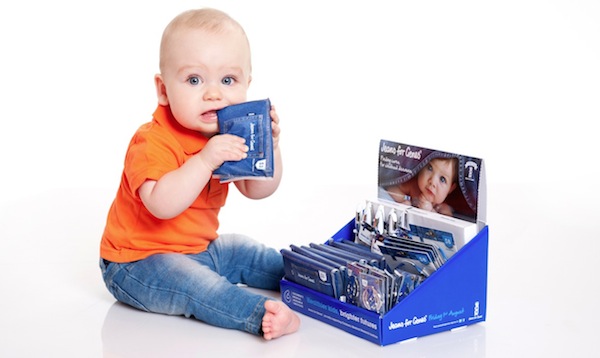At 21, Jeans For Genes Day’s marketing is all grown up
Share
21 years old this month, Australia’s Jeans for Genes Day was one of the first charity ‘days’ in the world. Over the years it has witnessed significant evolution in the not-for-profit fundraising space, says campaign manager Berry Kenyon.
A 21st birthday is a big celebration for anyone, and Jeans For Genes Day is making a big deal of that milestone this month.
Marketing spoke with Barry Kenyon, national campaign manager for the Children’s Medical Research Institute (CMRI), for which Jeans For Genes Day has been a major fundraising initiative since 1994. The CMRI is not government funded, but self-funded, making its year-round fundraising efforts vital. (Fun fact: the CMRI also held Australia’s first televised telethon.)
Australia was one of the first to hold ‘days’ for charity causes. Arguably the best known here are Red Nose Day, for sudden infant death syndrome (SIDS), and Jeans for Genes Day, for the CMRI’s work on congenital abnormality and genetic disease. For quite a while they were the only two that played in the sandpit, as far as charity days went.
‘Jeans for Genes’, a delightful play on the two words, traces its roots back to a brainstorming session in 1994, before charity days were a mainstay, it was decided that it was an unusual occurrence to wear jeans to work or to school. And Jeans For Genes Day was born.
It has since been exported to the UK, where an unaffiliated event of the same name takes place.
2014 is Kenyon’s second Jeans for Genes Day as campaign manager. Compared to the CMRI, which has been around for more than 50 years, he’s a relative newcomer.
Marketing: How different is running Jeans for Genes Day in 2014 compared to 1994?
Barry Kenyon: Totally different. I’ve seen some dramatic changes in the short time I’ve been here, but looking back through the archives and referring back to what we’ve done over that time, it’s been a dramatic change in landscape. It’s pretty interesting – it’s now more competitive than ever but a very interesting category to be in, the type of campaign that Jeans for Genes is. It’s been a fascinating evolution.
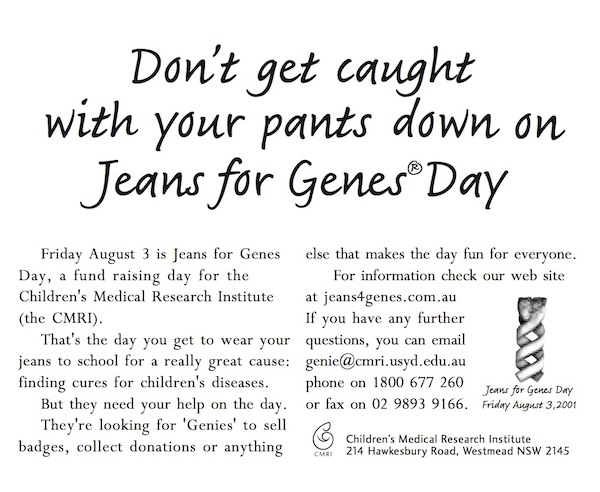
M: 21 years ago wearing jeans to work in most offices would have been novel. But jeans are a pretty common sight around many offices, most days of the week really.
Absolutely, yeah, and that’s a challenge we face today. ‘Let’s charge people for the privilege of wearing jeans to work and school on a particular day for the year’ – that was the premise of Jeans for Genes. A gold coin donation by people who would take it upon themselves to collect the money for us. That was the guise of Jeans for Genes for quite some time. As you said, it was quite novel to be able to wear them to school or work.
Over time that’s evolved. One of the challenges I face at the moment as a campaign manager is to keep relevance. We know now that in a lot of workplaces it’s not at all uncommon to be wearing jeans, so we needed to look for different ways to be able to generate income and still keep that relevancy.
So we started to develop badges, which you can imagine with our logo, the genes that are twisted into a double helix shape, which represents the genetic research we do. We developed that as a badge to be shown while you’re wearing the jeans so that people could understand you’re not just wearing jeans because you decided to have a ‘mufti day’, it’s for a cause.
But over time, merchandise started to become more and more relevant and people were more interested in buying merchandise. It gave a us a bit more of a footprint when we were out on the street, as well on the day itself.
Merchandise became a very key component of our campaign, and to this day we’re actually quite a heavily merchandise based campaign, a lot of our revenue comes from merchandise.
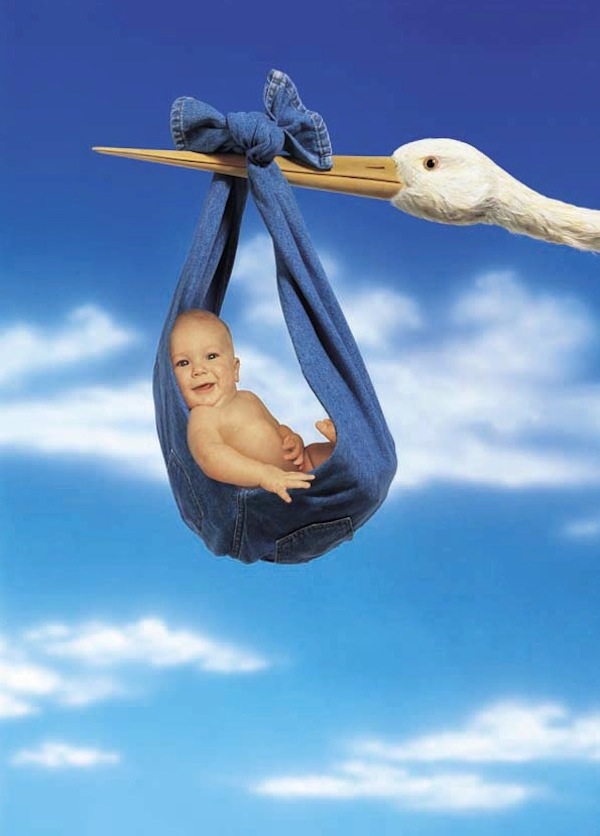
M: So income has really shifted from being a gold coin to wear jeans to the other channels of revenue like merchandise?
BK: That’s right, yeah. In most recent times, obviously the online ability to donate has become very prevalent with us as well, from either a communications point of view or also a physical way of us collecting and processing donations.
M: Soliciting donations online versus phone: which one works better?
BK: Our telemarketing doesn’t employ direct donations over the phone. If ever we talk to supporters or the general public it’s generally from a perspective of signing up to take receipt of some of our merchandise and take that into either the workplace or into the club to sell our merchandise for us.
A lot of our direct communications talk about that support level in the early instances, and in fact, that’s the process we’re in right now. 1 August is Jeans For Genes Day this year, it’s always the first Friday of August, and for several months we were heavily into securing and recruiting those supporters.
We nickname them ‘Genies’. They’re members of the public or retailers. Major national retailers will take our merchandise, display it, sell the merchandise on our behalf and then send in the money.
M: Can you give, proportionally over time, the shift from donations collected on the single day compared to throughout the campaign period?
BK: In the early days we relied purely on people at schools. That was our birthplace I suppose – a lot of the groundwork was done in schools, and that was based around the day itself.
Without knowing the exact figures, it was very heavily reliant on people holding a day or their own event to raise the money for us. If I had to give a number it was sort of 75-80% of the money was raised that way in the early days.
Now, with merchandise being such a big part of our campaign, it’s actually closer to 60% of our revenue is raised from merchandise, another 20% or so is raised from people who simply fundraise, [for example] collect money for us over that July period… and then the remaining 20% or so is collected on the day or just after the day via online donations or physical donations that happen with our street presence.
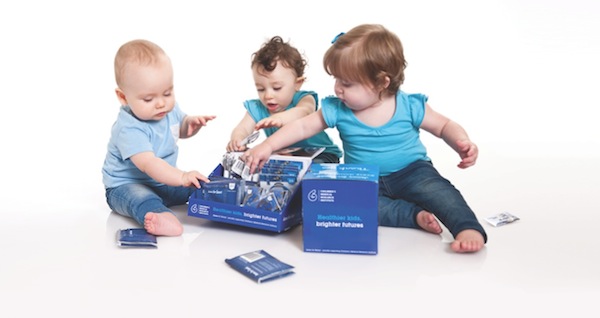
M: 21 years ago, what did campaign communications look like?
BK: Very limited means back then, very traditional. It was heavily ‘ambassadorial’ – if there’s such a word – we used a lot of celebrity support to gain traction, and it was mainly reliant around television support. And a lot of press and print materials, and that really all that was available to us back then.
M: So what now in 2014? Is social media a key?
BK: Yeah, we have a dedicated social media digital resource that is forever [looking for opportunities], because of how we can expedite our messaging.
For example, of all things, our PR firm twigged to the fact that on The Morning show with Larry Emdur and Kylie Gillies, Larry was wearing double denim. Someone recognised it in the office, and within a matter of minutes there was a phone call to the producer saying, ‘Look we’ve got some shots of celebrities like Kim Kardashian in double denim, can we have a bit of fun with making some fun out of Larry? What are you wearing today? Can we send a care package over?’
To cut a long story short, within the time the show was on air we managed to get from our office to the studio a swag bag of Jeans for Genes kit which secured us a good minute or a minute and a half of banter at the end of their show, which was great.
That’s the kind of thing that just happens ad hoc, it’s obviously never planned, and we’re very nimble and open to opportunities like that, but to round that out to the way we operate now, within minutes of that happening it was posted on Twitter, it was on Facebook, it was on our blog as well and out through our supporters online as much as it was in the immediate sense through the TV.
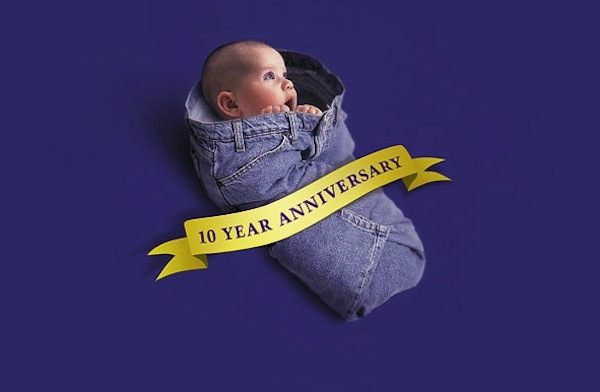
M: The speed of that is impressive. Without the budget of a commercial brand you’re still able to be really quick and responsive. Maybe you‘re even in a better position if it’s small teams?
BK: Well, that’s right. I’ve come the full circle as far as sizes go – I’m ex-Coca-Cola and I certainly know the protocols that can slow the process. With digital capability you need to be able to act quickly. I think we’ve got very strong guidelines and a very clear understanding of what is appropriate and how to frame things, so we don’t need to go through those checks and balances on every occasion, we’re able to leap on an opportunity that comes through.
M: That must be refreshing.
BK: Fabulous. Yeah, it is, no question, that’s gold. And you know, technology has allowed us to communicate and keep in touch with the Genies I mentioned earlier.
People that register with us obviously register their details and we stay in touch regularly with what’s coming up, or how to get involved this year if they were involved in previous years. It takes a bit of the reliance and a little bit of the cost out being able to communicate regularly, because in a direct sense, before the technology was available, it was all done by hard mail which was pretty costly, and actually very slow.
M: And you don’t know if they opened it.
BK: That’s right. Now with the ability to be able to track bounce rates and click-throughs, we’re able to just keep a very close relationship, as much as anything, and be able to monitor our communication effectively.

M: I was going to ask about email because I’m curious when the focus shifted towards collecting email addresses rather than the traditional details.
BK: It’s an organic thing, there’s no real moment in time. And I’m from an era where I’ve seen emails become more and more prevalent from a prehistoric age where they didn’t exist.
With the way they’ve organically grown it’s become part of our – I hate to use the word ‘data capture’ – but it’s very standard form of information, as standard as capturing someone’s phone number when we’re communicating with them. So, over time, the vast majority of our database contacts have email as their primary method of contact.
M: Do you still use physical mail?
BK: We do, and that’s when we may need to either give a little bit more information, we can provide booklets and leaflets and a little bit more information about the cause, as much as it is about the day, Jeans for Genes is a brand that has the profile.
We got a recent report that said we had 80% brand recognition. We’re really the face, I suppose, of the Children’s Medical Research Institute. One of the challenges we face, or one of the opportunities to bring the CMRI’s profile up alongside Jeans for Genes, is by education. The way to best do that with our supporters is to say, ‘You may know us primarily through Jeans for Genes, but here is a lot more information about what it is you’re getting involved in and why to do that.’
Then we’ll give them relative information about the research that we do, what happens here at CMRI and where that money goes.
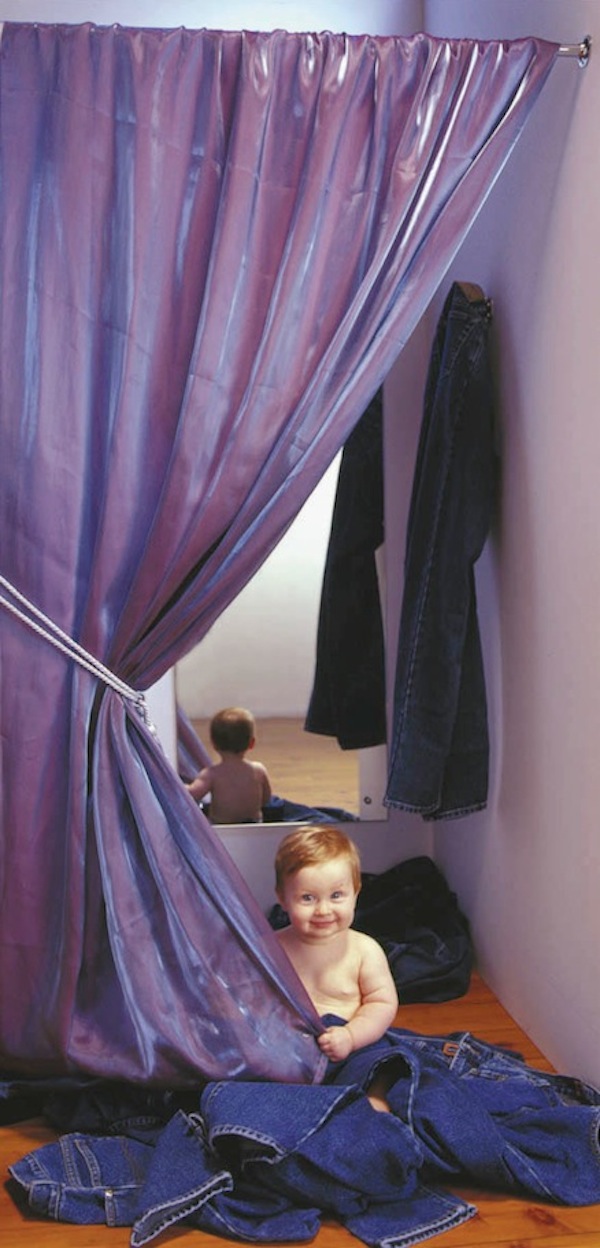
M: It started off as an annual fundraising event, but has there been effort in the past to spread that out over the year?
BK: Yeah. When I first started, one of the first objectives in my five-year strategy was to take out that lumpiness, where every year we build up from February, internally, and turn our focus through to walkers and then drop off. Our presence had that very high comet [nature] – it burnt bright for a short while but then tails off.
I would like to try to get to a point where we have multiple activations throughout the year. We’ve got a few private projects that we’re going to run next year, to look at ways of brand extending what Jeans for Genes means.
A good example of something that we did last year very successfully – it’s in [CMRI’s] community fundraising department, which is right next door to me and closely linked with Jeans for Genes – is a thing called The Great Cycle Challenge. This was just capturing how prolific cycling has become as a pastime.
There are a lot of these event type fundraisers around cycling, like a Tour to Cure, or A Ride to Conquer Cancer. Not everyone can do those, they’re either not up to it physically or they just can’t make the venue. We put together, with the help of an agency, a program that was peer-to-peer fundraising, of people that can just nominate themselves as someone to ride their bike and nominate how many kilometres they might do in the month of October, and then through various social media means that we equip them with they can be sponsored by their friends to take part in The Great Cycle Challenge.
In its first year that managed to raise $1 million for us, with around 4000 cyclists taking part.
M: So it’s Lycra for Genes instead of Jeans?
BK: We’re actually keeping the two brands apart, because as our community fundraising also has a few offshoots of the Jeans for Genes brand, which are peer-to-peer again, where an individual will collaborate with their friends. One of the initiatives was Jump for Genes, so they’re all the ‘Js’, we call them. Jump for Genes is an initiative where anyone can decide to hurl themselves out of an aeroplane, with a parachute of course. If they raise $1000 we have a relationship with a few jump centres around the country where they can jump for free, essentially.
It’s one of those things where we say that if you put yourself up to do this stunt, you can contact your friends and family via social media and say, ‘I’m prepared to leap out of an aeroplane if you support me to the tune of a combined amount of $1000 and I’ll take the jump and all the money goes to the Jeans for Genes charity’.
Another one of those is Jog for Genes, where anyone that does a recognised fun run can nominate themselves and we’ll give them a letter to authorise them to collect money on our behalf and they can donate that money. So someone might do the City to Surf or even the runs that happen around the Botanic Gardens, or something like that, and if they have their friends donate money towards them as a sponsorship that can be sent in to us via Jog for Genes.
We had one called Jam for Genes, a music-based one, so there’s a country jam happening this Saturday night in Sydney with a number of country music performers and all ticket sales and a portion of bar and all that kind of thing generates funds and comes through the Jeans for Genes as well.
M: Covering off very different interest groups.
BK: That’s right. This peer-to-peer fundraising is definitely one of the great growth segments of not for profit at the moment, which involves, I guess, a deeper relationship with the supporters, and in turn supporters of social networks.
M: How do you deal with the crowding of the space?
BK: 21 years ago we mentioned two names, and now there seems to be a charity day for every day of the year. It’s a funny segment because, coming from a corporate background where it’s kill or be killed, in the not-for-profit sector there is a real esprit de corps among the different charity organisations, and it’s a really refreshing experience that I’m still coming to grips with – the sharing of knowledge is tremendous.
We have regular industry communication evenings and the likes, and people are very generous with one another and sharing key learnings and the likes, but to the public it becomes quite cluttered, and I guess our challenge is to make a relevancy and always have that unique proposition which is our connection to Jeans. We’re in a very fortunate position where we have such a long and strong heritage but we’re ahead of the game in a lot of instances, but you know, the prevalence of new and really impressive organisations like Movember and Dry July.
We concentrate on really strong engagement, high levels of communication, and always leveraging the fact that it is an easy to be involved in fundraiser. Merchandise wise, by the way, is sent out at no charge, which sort of blew me away when I first started here. A fundraising box of pens and badges to people that are registered supporters, but nonetheless, people we don’t know personally. It’s all done in good faith and very, very rarely are we ever let down, it’s amazing.
